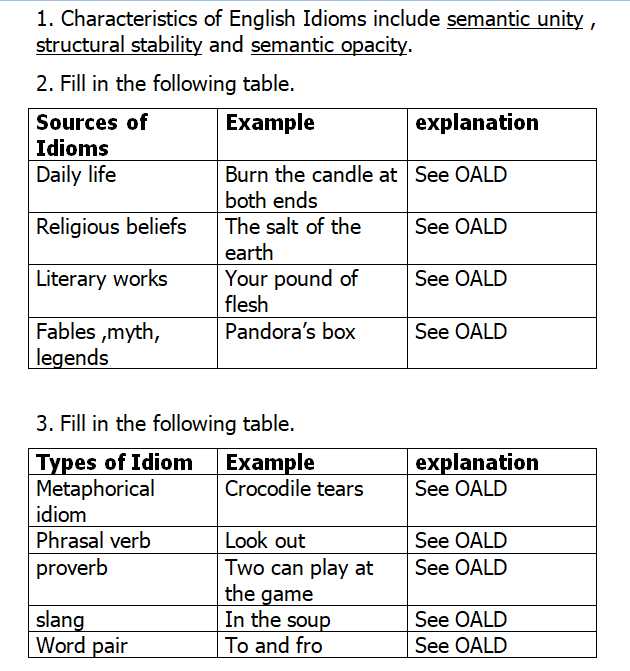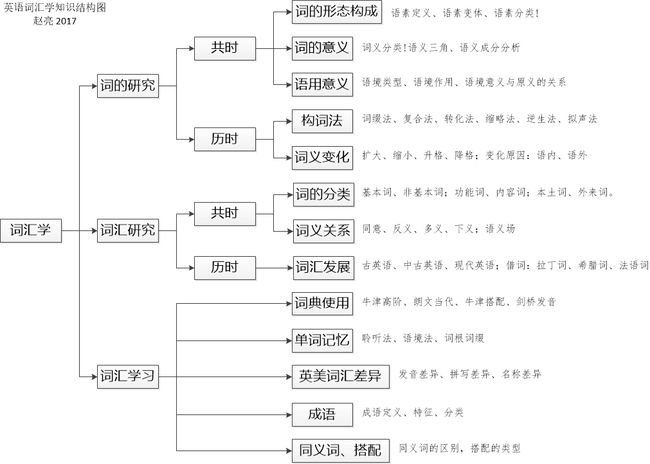习题4:词汇学习
第九章 词典使用
重点提示:牛津高阶,朗文当代,科林斯,搭配词典,发音词典,同义词词典,词根词典
难点提示:无
1. Dictionaries define words in various ways. Try to define the following words in the given way.
(1)bird (formal definition): a feathered creature with two legs and two wings, usually able to fly.
(2)beautiful (definition by synonym) : lovely or handsome.
(3)chilly(definition by antonym): not friendly.
(4)laugh(definition by context): when you laugh, you make a sound with your throast while smiling and show that you are happy or amused.
(5)seesaw(operational definition): a game played when children sit on opposite ends of the plank and go up and down alternately.
(6)blue(definition by example): of the color like the sky on a clear day or the deep sea when the sun is shining.
第十章 英美词汇差异
重点提示:发音差异,意义差异,拼写差异,
难点提示:
1. 英美英语最显著的系统性发音差异是元音后的/r/ 。 door, father
2. 两个元音间的/t/在美式英语读作/d/。water, better
3. 英音中的/ɒ/在美音中常读作/a:/; (hot)
英音中的/a:/在美音中常读作/æ/; (dance)
英音中的/ju:/在美音中常读作/u:/; (new)
英音中的/ʌ/在美音中常读作/ə/。 (love)
4. 将下列词语按照英式英语和美式英语归类。
英式 美式
nappy diaper
note bill
chemist's drugstore
petrol gasoline
lorry truck
underground subway
第十一章 成语
重点提示:成语的定义、特征、分类
难点提示:
第十二章 同义词与搭配
重点提示:同义词的意义区分;搭配的类型。
难点提示:
1. 同义词的意义通常存在一定差别,这些差别是什么?
(1)概念意义:意义的程度、范围等差别。
(2)联想意义:1)蕴含意义差别;2)文体差别;3)情感色彩差别;3)搭配与分布的差别。
(因为本题与“意义分类”知识点高度重合, 所以考试不考。)
2. 根据词语组合的密切程度,搭配可分为哪几种类型?
自由搭配、习惯性搭配、固定搭配。
free combination, fixed combination, natural collocation
固定型:a gust of wind, nod your head, shrug your shoulders.
习惯型搭配:rough life, chain smoker,happy ending
自由型:kill a bird, drink water
3. 按照所涉及词的词性,英语中的搭配主要有哪些类型?
第一大类:三大词类的互相搭配
(1)主语与谓语动词的搭配
日本人学会了中国的饮茶。
The Japanese became accustomed to the Chinese tea-drinking.
这件事告诉我们,他为人不诚实。
The incident showed that he is dishonest.
(2)动词与宾语的搭配
解决问题 solve a problem
回答问题 answer a question
讨论问题 discuss an issue
犯罪 commit a crime 犯错 make a mistake
关灯turn off the light (×close) 吃药take the medicine (×eat)
教师教了很多知识,但学生并没学到很多知识。
(×)The teacher taught a lot of knowledge, but the students didn’t learn a lot of knowledge.
(V)The teacher passed on a lot of knowledge,but the students didn’t gain alot of knowledge.
(3)形容词与名词的搭配
严重的错误 a grave mistake
巨大的危险 grave danger
浓茶 strong tea 淡茶 weak tea
浓汤 thick soup 淡汤 thin soup
第二大类:介词类搭配
(4)介词与名词的搭配
词汇学基础 foundation of lexicology
词汇学导论 introduction to lexicolgy
Please find a solution to this problem as soon as possible. 请尽快找到这个问题的解决方法。
在学校 at the school 在医院 in the hospital
(5)动词与介词的搭配
Please concentrate on one thing at a time. 一次请关注一件事情。
You can appeal to higher court. 你可以向更高法院上诉。
(6)形容词与介词的搭配
He is indifferent to my feelings. 他对我的感受毫不在意。
The country is rich in water. 这个国家水资源丰富。
第三大类:副词类搭配
(7)副词与动词的搭配
完全同意 completely/fully agree
衷心感谢 thank sb. sincerely/heartily
坚决反对 firmly/strongly oppose
严厉谴责 strongly condemn
(8)副词与形容词的搭配
非常生气 extremely angry
It is _________ to see a panda in the wild.
a) completely unusual
b) highly unusual √
c) deeply unusual
d) strongly unusual
At a price of £200 per bottle, that wine is _________.
a) absolutely expensive
b) ridiculously expensive √
c) strongly expensive
d) utterly expensive
总论
1. Organize the following terms into a tree diagram to show their logical relationship. Some of the terms may be used twice.
lexicology, study of individual words, study of vocabulary,
diachronic study, synchronic study, morphological structure,
word meaning, pragmatic meaning, word formation,
sense relations, vocabulary evolution, changes in word meaning,
classification of words.

